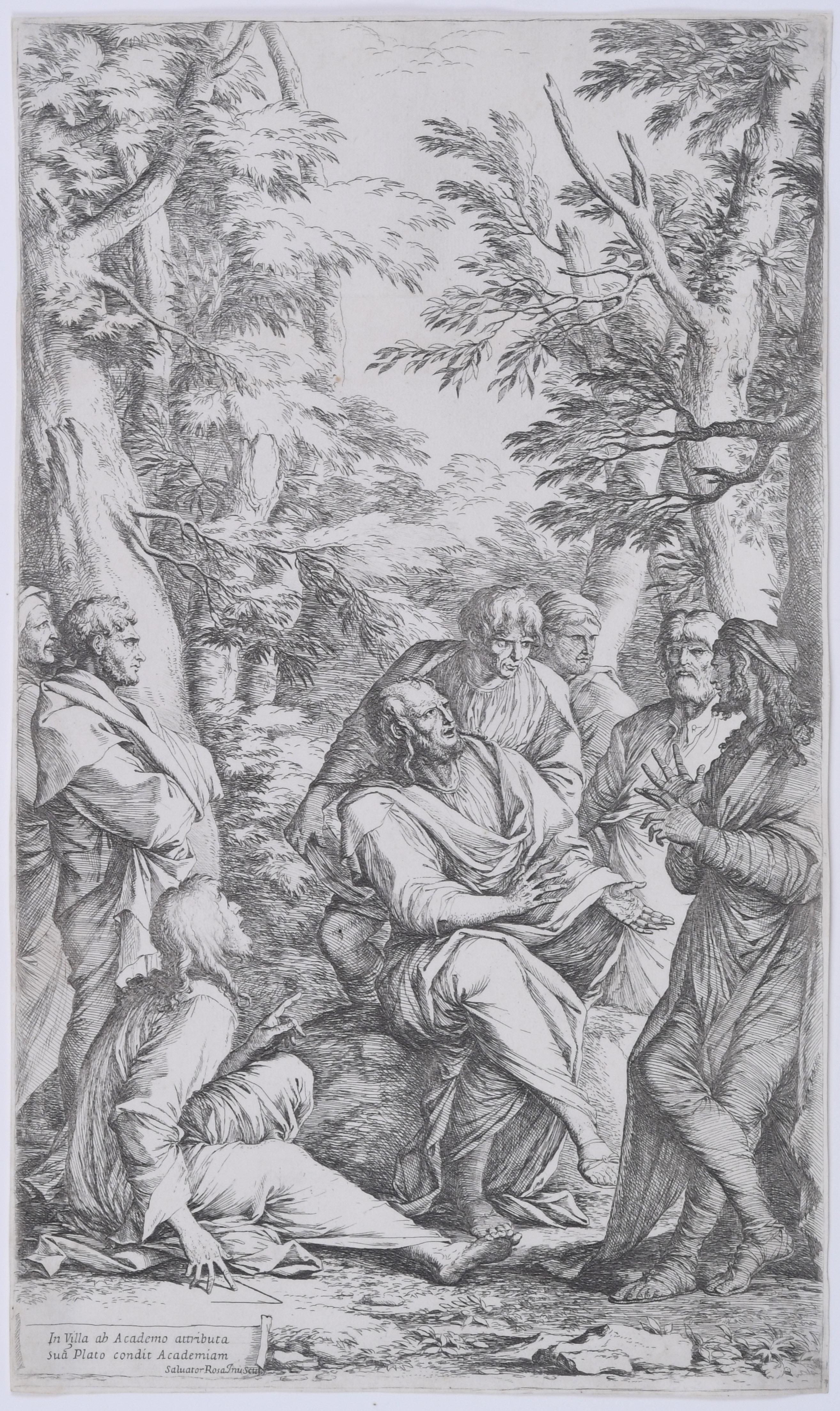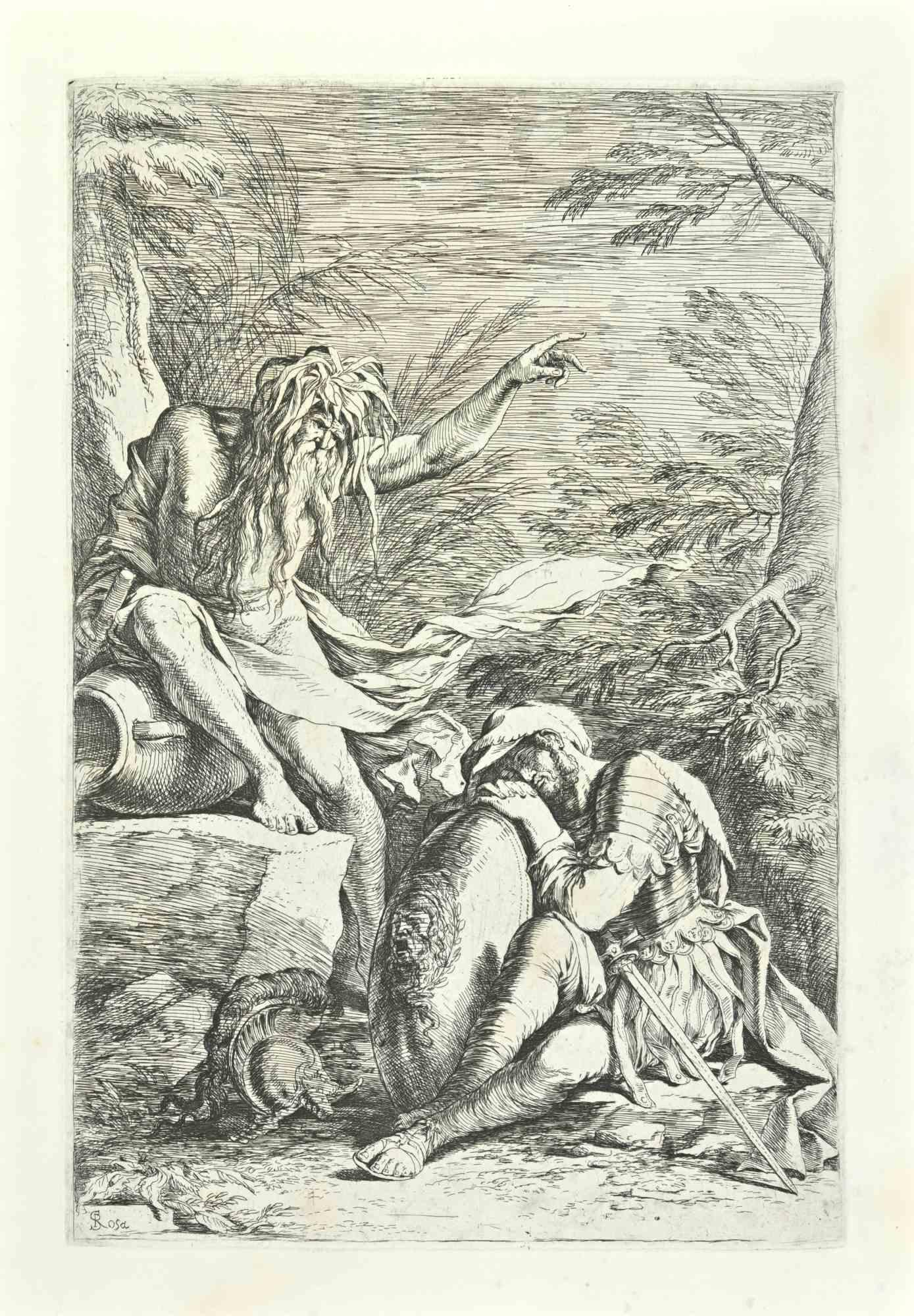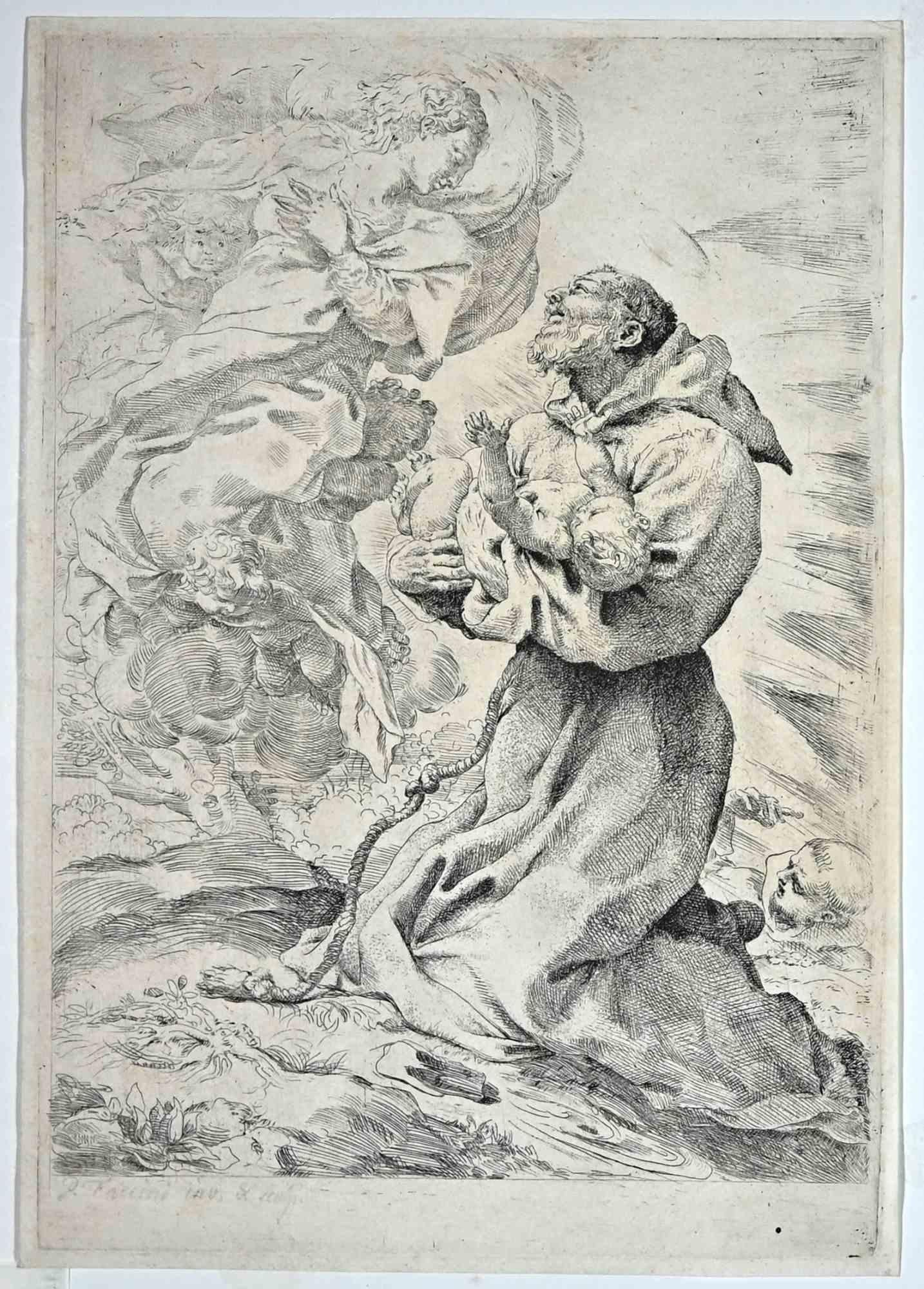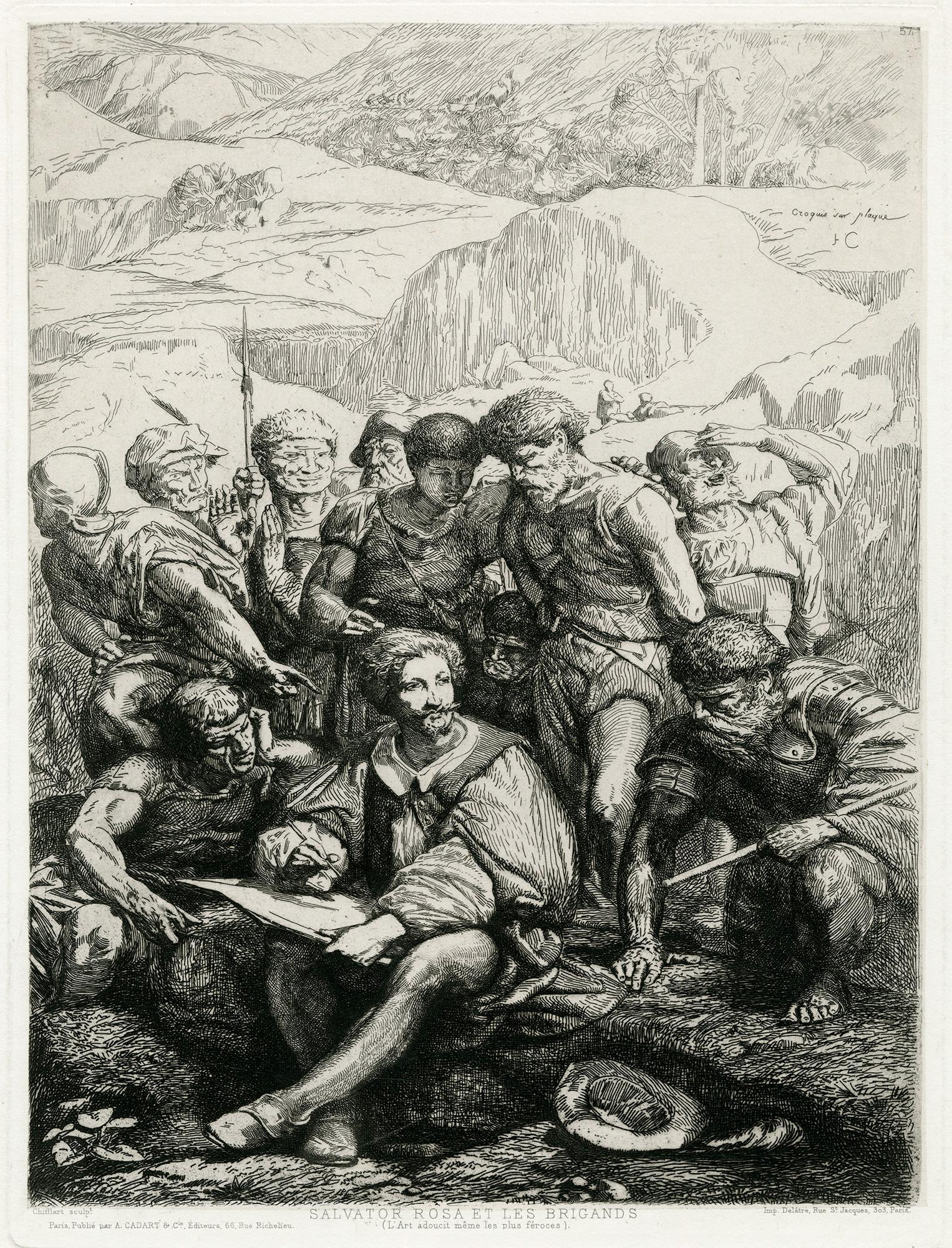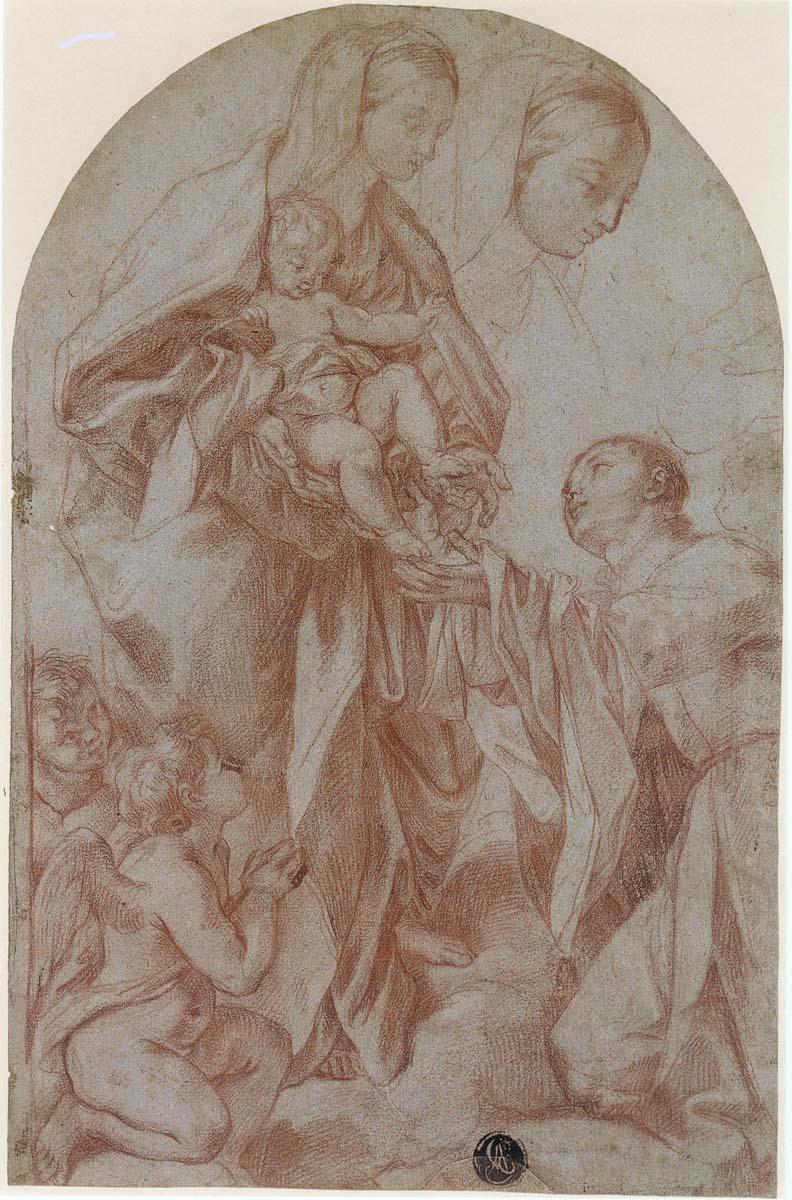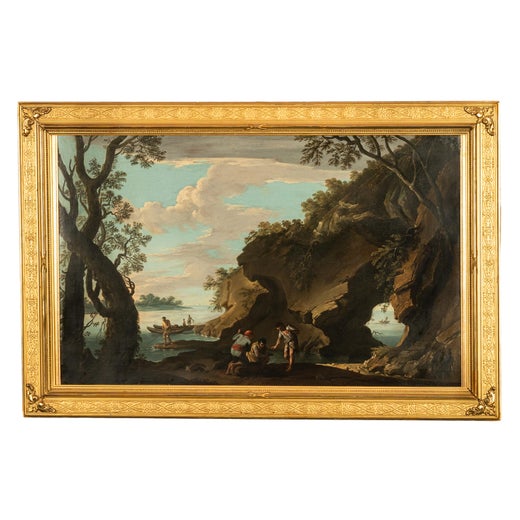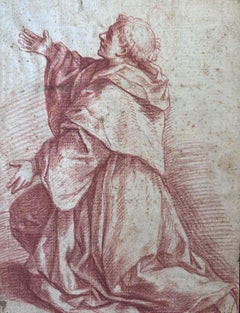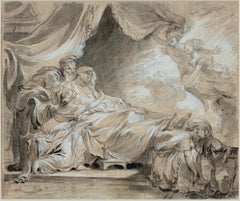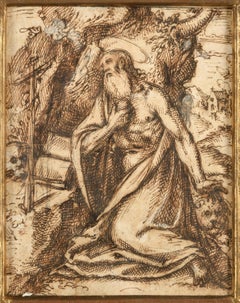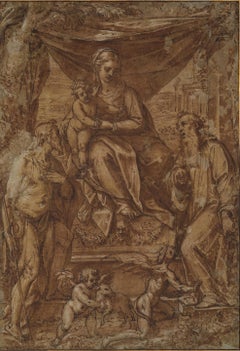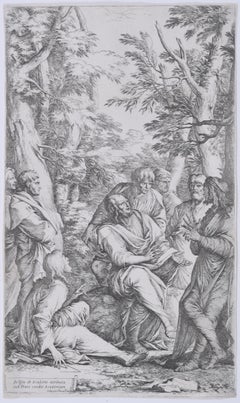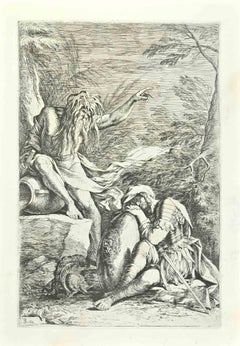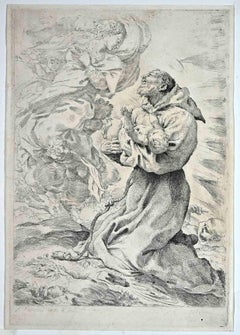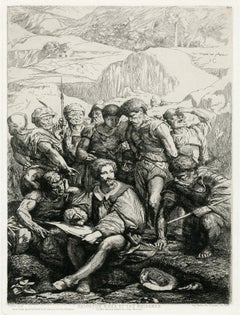Items Similar to Saint Francis of Assisi in Ecstasy
Video Loading
Want more images or videos?
Request additional images or videos from the seller
1 of 6
Salvator RosaSaint Francis of Assisi in Ecstasycirca 1650
circa 1650
$11,000
£8,396.96
€9,652.87
CA$15,478.97
A$17,213.25
CHF 9,040.77
MX$210,449.29
NOK 112,656.70
SEK 106,204.84
DKK 72,041.60
About the Item
Salvatore Rosa
(Naples 1615 - 1673 Rome)
Saint Francis of Assisi in Ecstasy
Pen and brown ink, brown wash over black chalk, on paper
7 x 5 cm
Bears the stamps of collections on the mount: lower left Giuseppe Vallardi (L. 1223); lower right Marie Marignane (L.1848) and lower Hubert Georges François Marignane (L. 5120).
Provenance:
Collection Giuseppe Vallardi (1784-1863);
Collection Marie Marignane, wife of Jacques Patissou;
Collection Hubert Georges François Marignane (1921-2002);
Private collection, France.
Salvator Rosa was a highly individualistic and unconventional figure in the Baroque era. His drawings, like his paintings, display a unique energy and a rebellious spirit that set him apart from many of his contemporaries.
This drawing, with its lively brushwork and dynamic composition, exhibits qualities that are in keeping with the Italian Baroque tradition. Previously given to Van Dyck, this sheet shows a real proximity in style, technique, and theme to the works of Salvator Rosa; let’s consider some key points.
The scene appears here to be dramatic, with figures arranged in a dynamic diagonal movement, which was common in Baroque compositions. Rosa, known for his dramatic and often fantastical subjects, frequently portrayed religious scenes with a sense of tension and movement. If you look at Rosa’s drawings and etchings, especially those done with pen and ink, they often convey a sense of restless energy, and his lines could be free-flowing, similar to what is seen here.
Rosa's drawings often feature dramatic, diagonally structured compositions, which create a strong sense of movement and tension. This is in line with the Baroque penchant for dynamic, emotionally charged works. His compositions often appear theatrical, with figures posed in exaggerated gestures and arranged in such a way that the scene feels as if it is unfolding in the moment. There’s an emphasis on storytelling, often through dramatic moments like in our drawing.
Here, the medium seems to be a combination of wash and ink or possibly sepia. Rosa often used similar techniques for his sketches, allowing him to achieve both broad, tonal effects and sharp, intricate details. The quick, energetic handling of the ink and wash seems reminiscent of Rosa's approach, especially the way he rendered figures with a somewhat sketchy, fluid outline while building depth through washes. He would often use a darker ink line to define key contours and then add tonal washes, which contributed to a sense of depth and volume in his compositions. This contrast creates a lively interplay between line and shading.
The treatment of the figures' faces and their slightly loose anatomy also resembles some of Rosa's known drawings. Rosa’s figures often show a rugged and somewhat exaggerated quality, especially in their facial expressions and movements. See for instance the drawings in the Louvre museum below:
• Salvatore Rosa, Romulus and Remus suckled by the she-wolf, under the gaze of many characters, pen and brown ink, brown wash over black chalk on beige paper, 24,2 x 40,8 cm, collections: Saint-Morys; INV. 9732.
• Salvatore Rosa, Allegory of Justice, pen and brown ink, brown wash, black chalk, bears an inscription in pen and brown ink lower left “S. Rosa”, 29,7 x 19,7 cm, collections: Saint-Morys, INV 9734.
• Salvatore Rosa, Half-nude man sustained by a man, pen and brown ink, brown wash, 19,7 x 13,5 cm, collections: Saint-Morys, INV 9750.
The atmospheric background, with swirling elements and dramatic poses, could be associated with Rosa’s typical focus on the emotional and chaotic elements of his scenes. Rosa’s sketches, particularly in his mature phase, often exhibit a raw and expressive quality, with dramatic contrasts of light and dark. He favored creating dramatic, almost theatrical scenes.
Comparing this drawing closely with known sketches by Rosa in major collections (such as the British Museum or the Louvre) solidifies this attribution. Rosa’s preparatory sketches, especially in wash and ink, share a lot of compositional and technical similarities with this drawing. See for instance:
• Salvatore Rosa, Woman with helmet and staff in her left hand sitting on a cloud (Athena), below a standing soldier in armor blinking up at her, 1660/1661, pen and brown ink, brown wash, 17 x 17,6 cm, Leipzig Museum der Bildenden Künste, Inv.-Nr.NI.8494.
• Humanitatis Fragilitatis, 1656/1657, pen and brown ink, brown wash, 20,2 x 17,3 cm, bears an inscription in pen and brown ink “a. Chigi”, Leipzig Museum der Bildenden Künste, Inv.-Nr.NI.8493.
Born in Naples in 1615, Salvator Rosa is best known today as an Italian Baroque painter, whose romanticized landscapes and history paintings, often set in dark and untamed nature, exerted considerable influence from the 17th century into the early 19th century. In his lifetime, he was among the most famous painters, known for his flamboyant personality, and regarded as an accomplished poet, satirist, actor, musician, and printmaker, as well.
- Creator:Salvator Rosa (1615 - 1673, Italian)
- Creation Year:circa 1650
- Dimensions:Height: 2.76 in (7 cm)Width: 1.97 in (5 cm)
- Medium:
- Movement & Style:
- Period:
- Condition:
- Gallery Location:Paris, FR
- Reference Number:1stDibs: LU2258215488462
Salvator Rosa
Rosa was an Italian painter of the Baroque period, as well as a printmaker, poet and author of satires. He was active in Naples, Rome and Florence, and best known for his unconventional and romantic landscapes, as well as his rebellious nature. Rosa was indisputably a leader in that tendency towards the romantic and picturesque, called a proto-romantic. His landscapes avoided the idyllic and pastoral calm in the landscapes of Claude Lorrain (1600 – 1682) and Paul Bril (1554 – 1626), and created brooding, melancholic fantasies, awash in ruins and brigands. As a writer, Rosa was equally romantic in his descriptions and rebellious in his attitude towards convention. Rosa began his training in Naples, notably with his future brother-in-law, Francesco Francanzano (1612 – 1657), who trained under the influential Spanish painter, Jusepe de Ribera (1591 – 1652), who Rosa may have trained with as well. It is also said that Rosa may have trained with the Naples painter, Aniello Falcone (1600 – 1665), who was also an apprentice to Ribera. After a brief trip to Rome, he returned to Naples and began painting his wildly romantic landscapes, eventually returning to Rome after 1638 painting one of his only altarpieces, Incredulity of Thomas. Something of a Baroque polymath, Rosa pursued his talents in music, poetry, writing, etching and acting. He wrote and often acted in his own Satires, which in turn gained him the reputation of a rebel, pitting him against powerful people, such as the prominent Roman sculptor, Bernini (1598 – 1680). This partially drove him away from Rome to sanctuary in Florence, patronized by a Medici Cardinal; he started his Accademia dei Percossi, or Academy of the Stricken, were artists, playwrights and poets gathered, among them the poet-painter, Lorenzo Lippi (1606 – 1664). He then returned to Naples, where it is said he engaged in the Spanish revolt of Masaniello (1622 – 1647), with some works produced showing this influence. He finally returned to Rome around 1649, painting historical works such as, Democritus amid Tombs, Death of Socrates, Regulus in the Spiked Cask, Justice Quitting the Earth and the Wheel of Fortune. The latter satirical work raised a storm of controversy, from which Rosa, endeavoring at conciliation, published a description of its meaning, but was nearly arrested. It was about this time that Rosa wrote his satire named Babylon, under which name Rome was of course his target. Among the pictures of his last years were the admired Battlepiece and Saul and the Witch of Endor, a work painted in 40 days, full of longdrawn carnage, with ships burning in the offing; Pythagoras and the Fishermen; and the Oath of Catiline. His output in painting and satirical writing was large, and both respected and contested in its time. Rosa, the man, is romanticized in several fictional works, including novels and fully scored ballets.
About the Seller
No Reviews Yet
Vetted Professional Seller
Every seller passes strict standards for authenticity and reliability
Established in 2010
1stDibs seller since 2022
Typical response time: 6 hours
- ShippingRetrieving quote...Shipping from: Paris, France
- Return Policy
Authenticity Guarantee
In the unlikely event there’s an issue with an item’s authenticity, contact us within 1 year for a full refund. DetailsMoney-Back Guarantee
If your item is not as described, is damaged in transit, or does not arrive, contact us within 7 days for a full refund. Details24-Hour Cancellation
You have a 24-hour grace period in which to reconsider your purchase, with no questions asked.Vetted Professional Sellers
Our world-class sellers must adhere to strict standards for service and quality, maintaining the integrity of our listings.Price-Match Guarantee
If you find that a seller listed the same item for a lower price elsewhere, we’ll match it.Trusted Global Delivery
Our best-in-class carrier network provides specialized shipping options worldwide, including custom delivery.More From This Seller
View AllItalian School, 17th century - Study for the Vision of Saint Anthony
Located in Paris, Île-de-France
Italian School, 17th century
Study for the Vision of Saint Anthony
Red chalk on paper
247 x 185 mm
Unsigned
Provenance
Private collection, Paris
Collection of Count Alessandro Mag...
Category
17th Century Old Masters Figurative Drawings and Watercolors
Materials
Chalk
The Death of Coresus
By Jean-Baptiste Greuze
Located in Paris, Île-de-France
JEAN-BAPTISTE GREUZE
(Tournus 1725 - 1805 Paris)
The Death of Coresus, circa 1750
Pen and brown ink, black ink tips, gray wash on black chalk, 455 x 385 cm
Bears on the reverse in ...
Category
18th Century Old Masters Figurative Drawings and Watercolors
Materials
Ink, Watercolor
Saint Jerome Praying, with a Landscape in the Background
Located in Paris, Île-de-France
STEFANO DALL’ARZERE
(Padua, circa 1520 – 1570)
Saint Jerome Praying, with a Landscape in the Background
Pen and brown ink, heightened with white over black chalk lines
15.5 x 12 cm...
Category
16th Century Old Masters Landscape Drawings and Watercolors
Materials
Ink
Virgin and Child with Saint John the Baptist and Saint Jerome
Located in Paris, Île-de-France
Felice Pinariccio, known as Le Lasagna (active in Bologna during the 1560s-1570s)
Virgin and Child with Saint John the Baptist and Saint Jerome
Pen and brown ink, brown wash heighte...
Category
16th Century Old Masters Figurative Drawings and Watercolors
Materials
Ink
Studies of a kneeling female figure, an arm, a hand, and a head in profile
By Carlo Maratta (Ancona 1625 - Rome 1713)
Located in Paris, Île-de-France
Studio of Carlo Maratti (or Maratta)
Camerano 1625 – Rome 1713
Studies of a kneeling female figure, an arm, a hand, and a head in profile
Red chalk on paper
43.4 x 26.6 cm
Unsigne...
Category
Late 17th Century Old Masters Figurative Drawings and Watercolors
Materials
Chalk
The Holy Family with the Infant Saint John the Baptist
By Raphael (Raffaello Sanzio da Urbino)
Located in Paris, Île-de-France
STUDIO OF RAFFAELLO SANZIO, called RAPHAEL
(Urbino 1483 – Rome 1520)
Title The Holy Family with the Infant Saint John the Baptist
Medium Pen and brown ink, brown wash, over black ch...
Category
16th Century Old Masters Figurative Drawings and Watercolors
Materials
Ink
You May Also Like
The Academy of Plato Plato and His Disciples
By Salvator Rosa
Located in Fairlawn, OH
The Academy of Plato
Plato and His Disciples
Etching and drypoint
c. 1662, printed c. 1710
Signed in the plate lower left
Inscribed lower left: 'In villa ab Academo attributa sua[m]...
Category
1660s Old Masters Figurative Prints
Materials
Etching
Dream of Aeneas - Etching after Salvator Rosa - 18th Century
By Salvator Rosa
Located in Roma, IT
This etching, representing The Dream of Aeneas, is an 18th century proof after Salvator Rosa (ca. 1663).
Signed lower left “S.Rosa”
The state of preservation is good. Some foxings ...
Category
18th Century Old Masters Figurative Prints
Materials
Etching
Saint Francis with the Christ Child - Etching by Pietro Faccini - 17th Century
By Pietro Faccini
Located in Roma, IT
Saint Francis with the Christ Child is an etching print on paper realized by Pietro Faccini (1562-1602)
Beautiful proof.
Provenance: Collection G.S.S. Laub (Lugt 1221). Ref. Cat. P...
Category
17th Century Old Masters Figurative Prints
Materials
Etching
Salvator Rosa et les Brigands; ..L'Art adoucit même les plus féroces
Located in Middletown, NY
"Art softens even the most ferocious."
Paris: Cadart & Luquet, 1865.
Etching and engraving on Chine-collé mounted to watermarked Aqua-Fortistes cream laid paper, 12 1/2 x 9 1/2 inc...
Category
Mid-19th Century French School Landscape Prints
Materials
Handmade Paper, Engraving, Etching
Madonna and Child and Saint with Two Angels
Located in Chicago, IL
This confidently executed drawing is a study related to Maratta’s painting La Vergine appare a S.Stanislao Kotska 1687 in the second chapel to the right, in the church of S. Andrea a...
Category
17th Century Old Masters Drawings and Watercolor Paintings
Materials
Chalk
After Annibale Carracci (1560-1609) - 1627 Engraving, The Agony in the Garden
Located in Corsham, GB
A 17th century engraving by Lucas Vorsterman I (1595-1675) after 'The Agony in the Garden' by Annibale Carracci (1560-1609). According to the lettering, this plate was made at the co...
Category
Early 18th Century Figurative Prints
Materials
Engraving
More Ways To Browse
Old Master Italian Drawings
Old Antique Keys
Saint George Painting
Old Master Sketch
Sepia Drawing
Maned Wolf
Black Ink Etching Painting
17th Century Italian Drawings
Soldier Etching
Antique Athena
Nude Old Man
Antique Ink Well Set
Jacques Antiques
Athena Painting
Nude Soldier
The Louvre Antiques
Antique Technical Drawing Set
Francis Assisi
